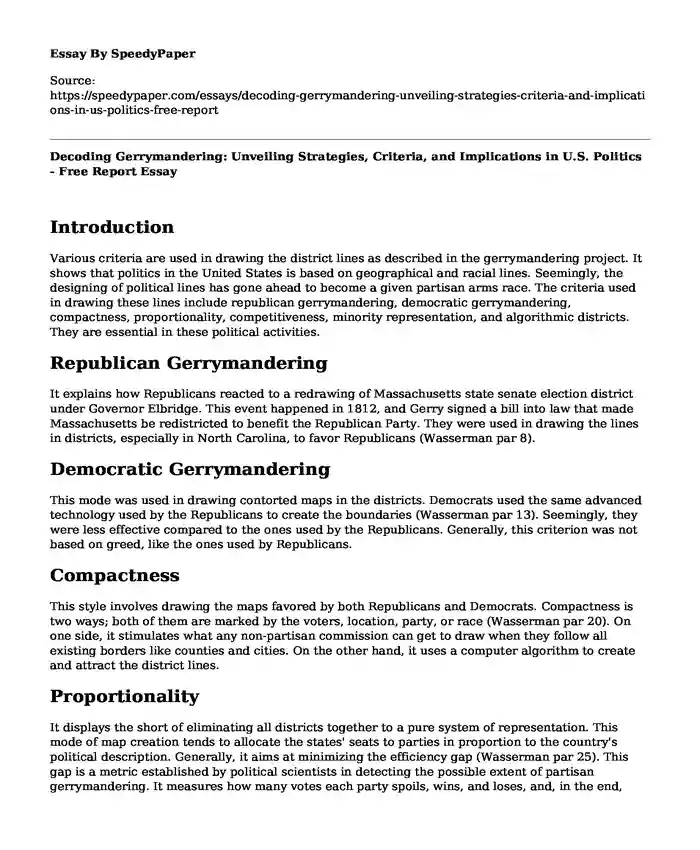
| Type of paper: | Essay |
| Categories: | Politics Discrimination |
| Pages: | 3 |
| Wordcount: | 680 words |
Introduction
Various criteria are used in drawing the district lines as described in the gerrymandering project. It shows that politics in the United States is based on geographical and racial lines. Seemingly, the designing of political lines has gone ahead to become a given partisan arms race. The criteria used in drawing these lines include republican gerrymandering, democratic gerrymandering, compactness, proportionality, competitiveness, minority representation, and algorithmic districts. They are essential in these political activities.
Republican Gerrymandering
It explains how Republicans reacted to a redrawing of Massachusetts state senate election district under Governor Elbridge. This event happened in 1812, and Gerry signed a bill into law that made Massachusetts be redistricted to benefit the Republican Party. They were used in drawing the lines in districts, especially in North Carolina, to favor Republicans (Wasserman par 8).
Democratic Gerrymandering
This mode was used in drawing contorted maps in the districts. Democrats used the same advanced technology used by the Republicans to create the boundaries (Wasserman par 13). Seemingly, they were less effective compared to the ones used by the Republicans. Generally, this criterion was not based on greed, like the ones used by Republicans.
Compactness
This style involves drawing the maps favored by both Republicans and Democrats. Compactness is two ways; both of them are marked by the voters, location, party, or race (Wasserman par 20). On one side, it stimulates what any non-partisan commission can get to draw when they follow all existing borders like counties and cities. On the other hand, it uses a computer algorithm to create and attract the district lines.
Proportionality
It displays the short of eliminating all districts together to a pure system of representation. This mode of map creation tends to allocate the states' seats to parties in proportion to the country's political description. Generally, it aims at minimizing the efficiency gap (Wasserman par 25). This gap is a metric established by political scientists in detecting the possible extent of partisan gerrymandering. It measures how many votes each party spoils, wins, and loses, and, in the end, favors parties in proportion to the political description of the states, whether Democratic or Republican.
Competitiveness
In this case, it involves drawing many competitive district maps by gerrymandering. It makes them competitively possible politically. There are 242 districts where both parties have at least one out of 6 chances of winning (Wasserman par 29). This fact shows how competitive it is in the sections. This mode does not favor any group but improves competition.
Minority Representation
This model tends to ensure that the rights of minorities are highly respected. Majority-minority districts have gone ahead to do more favors for Republicans than other minorities. Seemingly, this factor was because they made the surrounding neighborhoods whiter and more Republican (Wasserman par 35). Such criteria help answer questions about racial discrimination by other legislators.
Algorithmic Districts
These maps use the algorithm of census blocks in drawing the district's lines. Essentially, through these blocks, they can minimize the average distance between constituents and the central locations of communities (Wasserman par 38). It does not regard present jurisdictional boundaries like those of counties which can make an uphill task for the election administration. Indeed, it favors this electoral leadership.
Best Criteria
The best map description is the one that encourages the observation of the rights of minorities. It is the fairest map created among all of the seven of them. This factor is genuine because it helps fight for the rights of those discriminated against on political lines. The division of district lines based on this mode will help to promote their rights.
When it comes to the two criteria, the one to be used is democratic gerrymandering. It provides fewer chances for discrimination to the people once the boundaries are set. The others will create more political heat and further suppression. Apart from that, it provides more chances for legislators and the oppressed to express their pleas when it comes to district boundaries. This fact shows how the two, democratic gerrymandering and minority discrimination are essential.
Works Cited
Wasserman, David. Hating Gerrymandering Is Easy. Fixing it is Harder. 2018. https://fivethirtyeight.com/features/hating-gerrymandering-is-easy-fixing-it-is-harder/
Cite this page
Decoding Gerrymandering: Unveiling Strategies, Criteria, and Implications in U.S. Politics - Free Report. (2023, Dec 31). Retrieved from https://speedypaper.net/essays/decoding-gerrymandering-unveiling-strategies-criteria-and-implications-in-us-politics-free-report
Request Removal
If you are the original author of this essay and no longer wish to have it published on the SpeedyPaper website, please click below to request its removal:
- Free Essay on the Views of Langston Hughes on America
- Free Essay with the Fusion Centers Research
- Essay Sample on Dred Scott Decision
- The Role Played by Race in Enslaving Africans in America, Free Essay Sample
- Free Essay in Philosophy: Strong Objectivity and Standpoint Theory
- Essay Sample on Ethics in Business
- Paper Example. Determining the Target Population
Popular categories




